page 21 VOLVO S40 2003 Owners Manual
[x] Cancel search | Manufacturer: VOLVO, Model Year: 2003, Model line: S40, Model: VOLVO S40 2003Pages: 85, PDF Size: 1.75 MB
Page 1 of 85
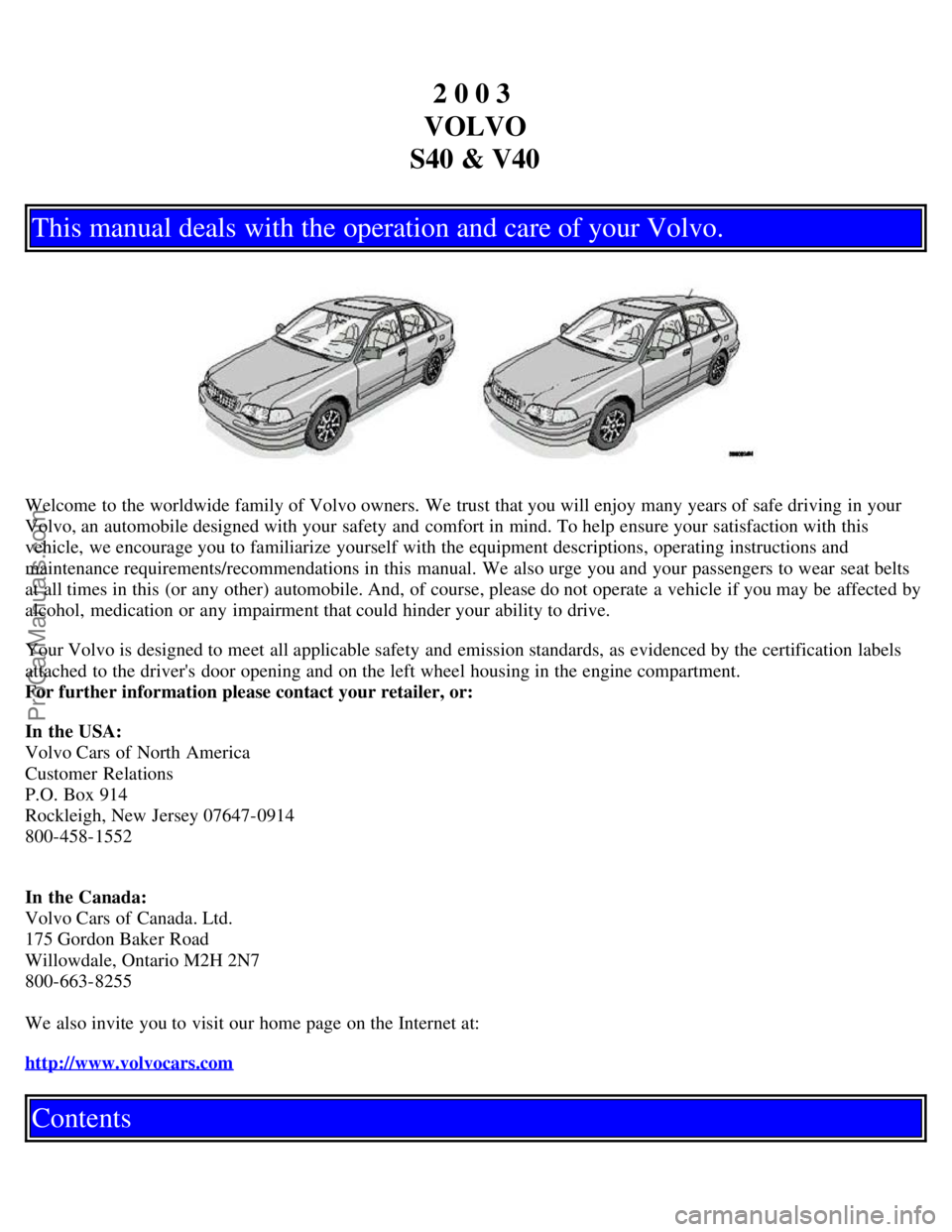
2 0 0 3
VOLVO
S40 & V40
This manual deals with the operation and care of your Volvo.
Welcome to the worldwide family of Volvo owners. We trust that you will enjoy many years of safe driving in your
Volvo, an automobile designed with your safety and comfort in mind. To help ensure your satisfaction with this
vehicle, we encourage you to familiarize yourself with the equipment descriptions, operating instructions and
maintenance requirements/recommendations in this manual. We also urge you and your passengers to wear seat belts
at all times in this (or any other) automobile. And, of course, please do not operate a vehicle if you may be affected by
alcohol, medication or any impairment that could hinder your ability to drive.
Your Volvo is designed to meet all applicable safety and emission standards, as evidenced by the certification labels
attached to the driver's door opening and on the left wheel housing in the engine compartment.
For further information please contact your retailer, or:
In the USA:
Volvo Cars of North America
Customer Relations
P.O. Box 914
Rockleigh, New Jersey 07647-0914
800-458-1552
In the Canada:
Volvo Cars of Canada. Ltd.
175 Gordon Baker Road
Willowdale, Ontario M2H 2N7
800-663-8255
We also invite you to visit our home page on the Internet at:
http://www.volvocars.com
Contents
ProCarManuals.com
Page 2 of 85
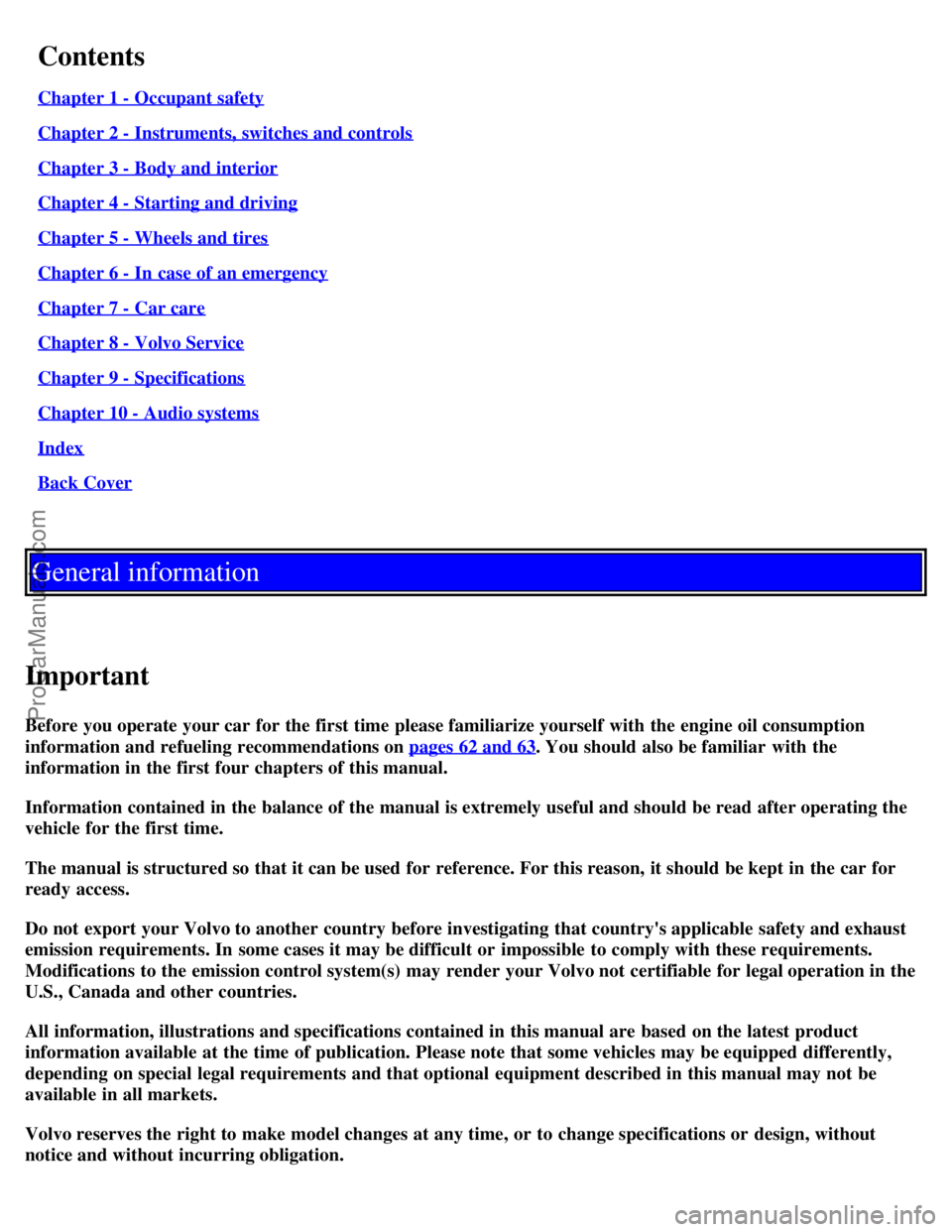
Contents
Chapter 1 - Occupant safety
Chapter 2 - Instruments, switches and controls
Chapter 3 - Body and interior
Chapter 4 - Starting and driving
Chapter 5 - Wheels and tires
Chapter 6 - In case of an emergency
Chapter 7 - Car care
Chapter 8 - Volvo Service
Chapter 9 - Specifications
Chapter 10 - Audio systems
Index
Back Cover
General information
Important
Before you operate your car for the first time please familiarize yourself with the engine oil consumption
information and refueling recommendations on pages 62 and 63
. You should also be familiar with the
information in the first four chapters of this manual.
Information contained in the balance of the manual is extremely useful and should be read after operating the
vehicle for the first time.
The manual is structured so that it can be used for reference. For this reason, it should be kept in the car for
ready access.
Do not export your Volvo to another country before investigating that country's applicable safety and exhaust
emission requirements. In some cases it may be difficult or impossible to comply with these requirements.
Modifications to the emission control system(s) may render your Volvo not certifiable for legal operation in the
U.S., Canada and other countries.
All information, illustrations and specifications contained in this manual are based on the latest product
information available at the time of publication. Please note that some vehicles may be equipped differently,
depending on special legal requirements and that optional equipment described in this manual may not be
available in all markets.
Volvo reserves the right to make model changes at any time, or to change specifications or design, without
notice and without incurring obligation.
ProCarManuals.com
Page 3 of 85
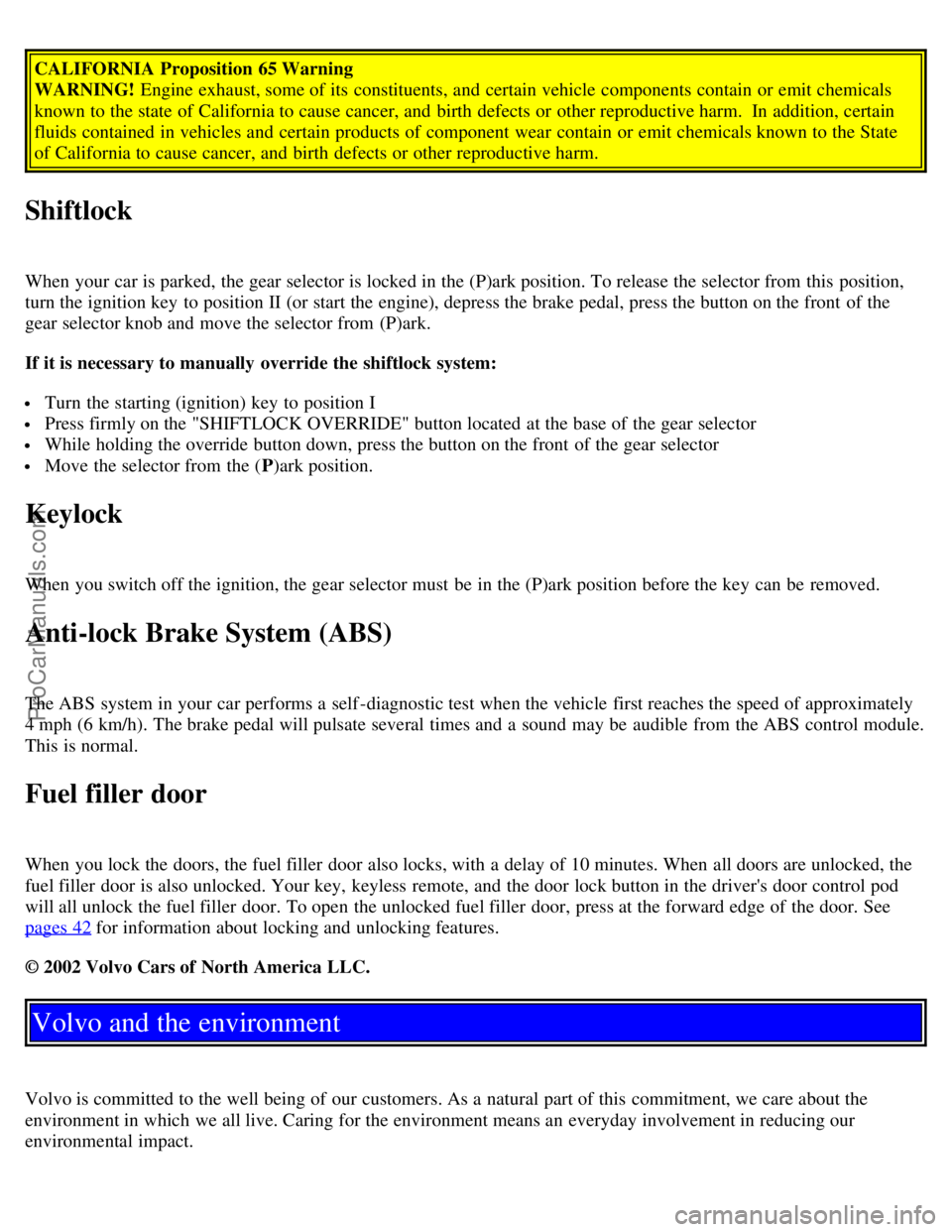
CALIFORNIA Proposition 65 Warning
WARNING! Engine exhaust, some of its constituents, and certain vehicle components contain or emit chemicals
known to the state of California to cause cancer, and birth defects or other reproductive harm.
In addition, certain
fluids contained in vehicles and certain products of component wear contain or emit chemicals known to the State
of California to cause cancer, and birth defects or other reproductive harm.
Shiftlock
When your car is parked, the gear selector is locked in the (P)ark position. To release the selector from this position,
turn the ignition key to position II (or start the engine), depress the brake pedal, press the button on the front of the
gear selector knob and move the selector from (P)ark.
If it is necessary to manually override the shiftlock system:
Turn the starting (ignition) key to position I
Press firmly on the "SHIFTLOCK OVERRIDE" button located at the base of the gear selector
While holding the override button down, press the button on the front of the gear selector
Move the selector from the ( P)ark position.
Keylock
When you switch off the ignition, the gear selector must be in the (P)ark position before the key can be removed.
Anti-lock Brake System (ABS)
The ABS system in your car performs a self -diagnostic test when the vehicle first reaches the speed of approximately
4 mph (6 km/h). The brake pedal will pulsate several times and a sound may be audible from the ABS control module.
This is normal.
Fuel filler door
When you lock the doors, the fuel filler door also locks, with a delay of 10 minutes. When all doors are unlocked, the
fuel filler door is also unlocked. Your key, keyless remote, and the door lock button in the driver's door control pod
will all unlock the fuel filler door. To open the unlocked fuel filler door, press at the forward edge of the door. See
pages 42
for information about locking and unlocking features.
© 2002 Volvo Cars of North America LLC.
Volvo and the environment
Volvo is committed to the well being of our customers. As a natural part of this commitment, we care about the
environment in which we all live. Caring for the environment means an everyday involvement in reducing our
environmental impact.
ProCarManuals.com
Page 4 of 85
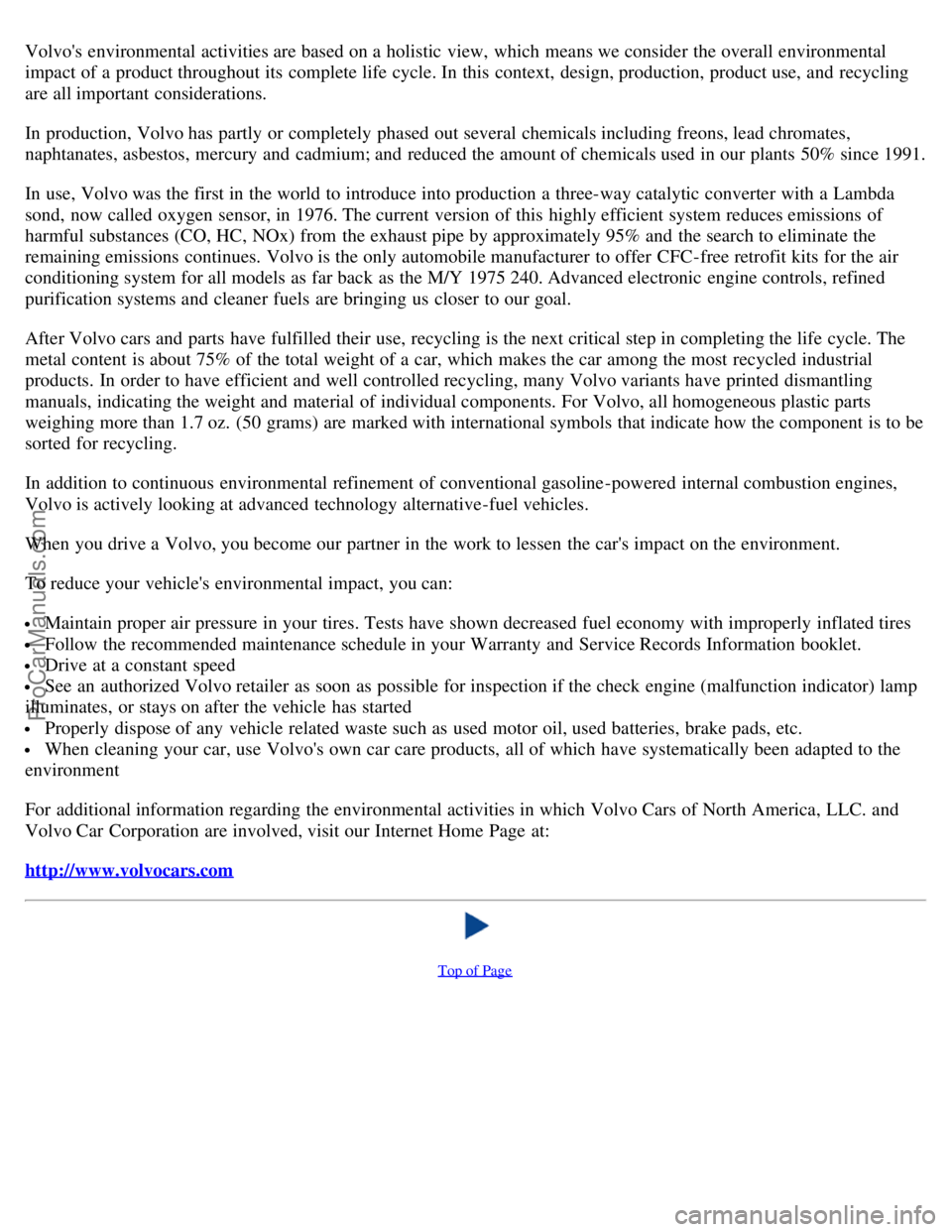
Volvo's environmental activities are based on a holistic view, which means we consider the overall environmental
impact of a product throughout its complete life cycle. In this context, design, production, product use, and recycling
are all important considerations.
In production, Volvo has partly or completely phased out several chemicals including freons, lead chromates,
naphtanates, asbestos, mercury and cadmium; and reduced the amount of chemicals used in our plants 50% since 1991.
In use, Volvo was the first in the world to introduce into production a three-way catalytic converter with a Lambda
sond, now called oxygen sensor, in 1976. The current version of this highly efficient system reduces emissions of
harmful substances (CO, HC, NOx) from the exhaust pipe by approximately 95% and the search to eliminate the
remaining emissions continues. Volvo is the only automobile manufacturer to offer CFC-free retrofit kits for the air
conditioning system for all models as far back as the M/Y 1975 240. Advanced electronic engine controls, refined
purification systems and cleaner fuels are bringing us closer to our goal.
After Volvo cars and parts have fulfilled their use, recycling is the next critical step in completing the life cycle. The
metal content is about 75% of the total weight of a car, which makes the car among the most recycled industrial
products. In order to have efficient and well controlled recycling, many Volvo variants have printed dismantling
manuals, indicating the weight and material of individual components. For Volvo, all homogeneous plastic parts
weighing more than 1.7 oz. (50 grams) are marked with international symbols that indicate how the component is to be
sorted for recycling.
In addition to continuous environmental refinement of conventional gasoline-powered internal combustion engines,
Volvo is actively looking at advanced technology alternative-fuel vehicles.
When you drive a Volvo, you become our partner in the work to lessen the car's impact on the environment.
To reduce your vehicle's environmental impact, you can:
Maintain proper air pressure in your tires. Tests have shown decreased fuel economy with improperly inflated tires
Follow the recommended maintenance schedule in your Warranty and Service Records Information booklet.
Drive at a constant speed
See an authorized Volvo retailer as soon as possible for inspection if the check engine (malfunction indicator) lamp
illuminates, or stays on after the vehicle has started
Properly dispose of any vehicle related waste such as used motor oil, used batteries, brake pads, etc.
When cleaning your car, use Volvo's own car care products, all of which have systematically been adapted to the
environment
For additional information regarding the environmental activities in which Volvo Cars of North America, LLC. and
Volvo Car Corporation are involved, visit our Internet Home Page at:
http://www.volvocars.com
Top of Page
ProCarManuals.com
Page 8 of 85
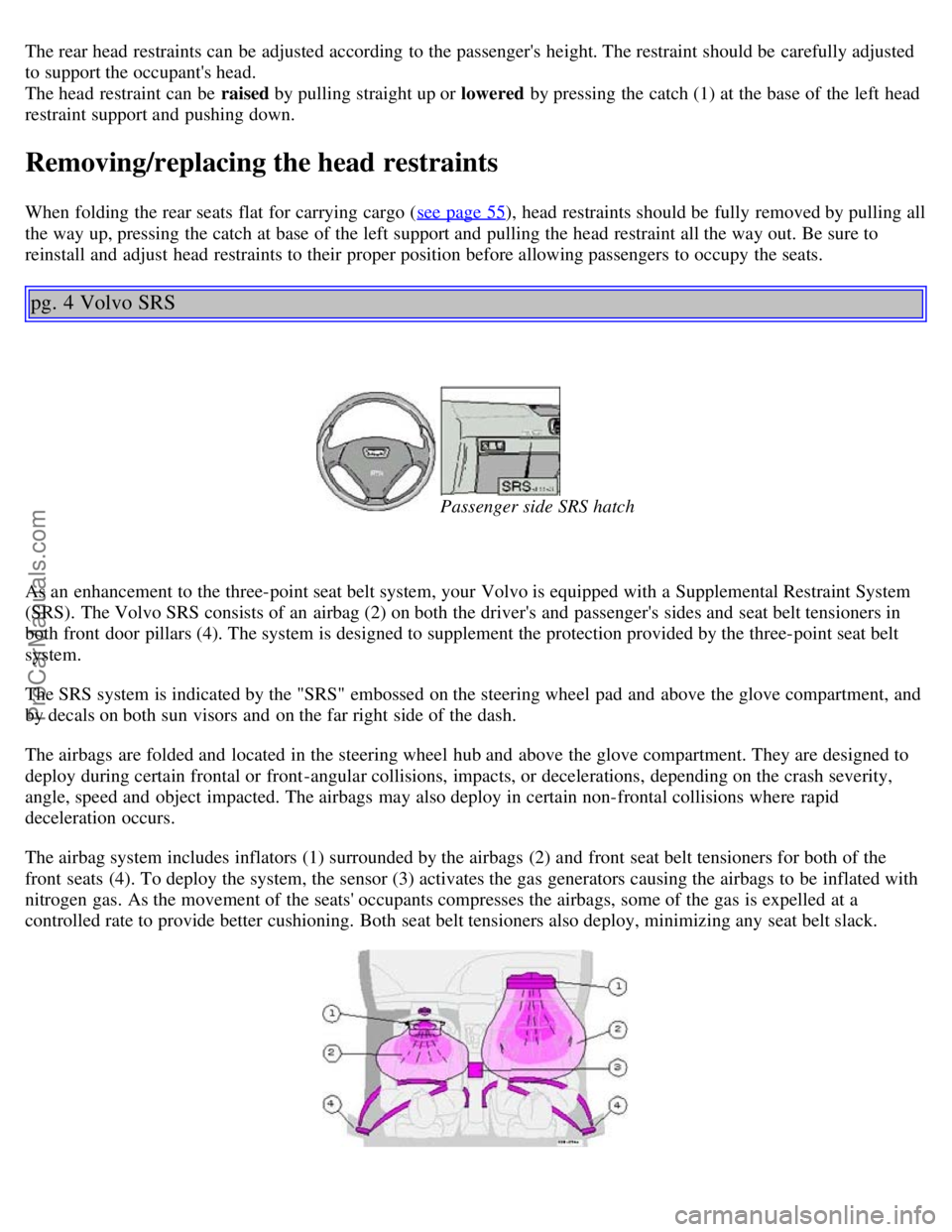
The rear head restraints can be adjusted according to the passenger's height. The restraint should be carefully adjusted
to support the occupant's head.
The head restraint can be raised by pulling straight up or lowered by pressing the catch (1) at the base of the left head
restraint support and pushing down.
Removing/replacing the head restraints
When folding the rear seats flat for carrying cargo ( see page 55), head restraints should be fully removed by pulling all
the way up, pressing the catch at base of the left support and pulling the head restraint all the way out. Be sure to
reinstall and adjust head restraints to their proper position before allowing passengers to occupy the seats.
pg. 4 Volvo SRS
Passenger side SRS hatch
As an enhancement to the three-point seat belt system, your Volvo is equipped with a Supplemental Restraint System
(SRS). The Volvo SRS consists of an airbag (2) on both the driver's and passenger's sides and seat belt tensioners in
both front door pillars (4). The system is designed to supplement the protection provided by the three-point seat belt
system.
The SRS system is indicated by the "SRS" embossed on the steering wheel pad and above the glove compartment, and
by decals on both sun visors and on the far right side of the dash.
The airbags are folded and located in the steering wheel hub and above the glove compartment. They are designed to
deploy during certain frontal or front -angular collisions, impacts, or decelerations, depending on the crash severity,
angle, speed and object impacted. The airbags may also deploy in certain non-frontal collisions where rapid
deceleration occurs.
The airbag system includes inflators (1) surrounded by the airbags (2) and front seat belt tensioners for both of the
front seats (4). To deploy the system, the sensor (3) activates the gas generators causing the airbags to be inflated with
nitrogen gas. As the movement of the seats' occupants compresses the airbags, some of the gas is expelled at a
controlled rate to provide better cushioning. Both seat belt tensioners also deploy, minimizing any seat belt slack.
ProCarManuals.com
Page 11 of 85
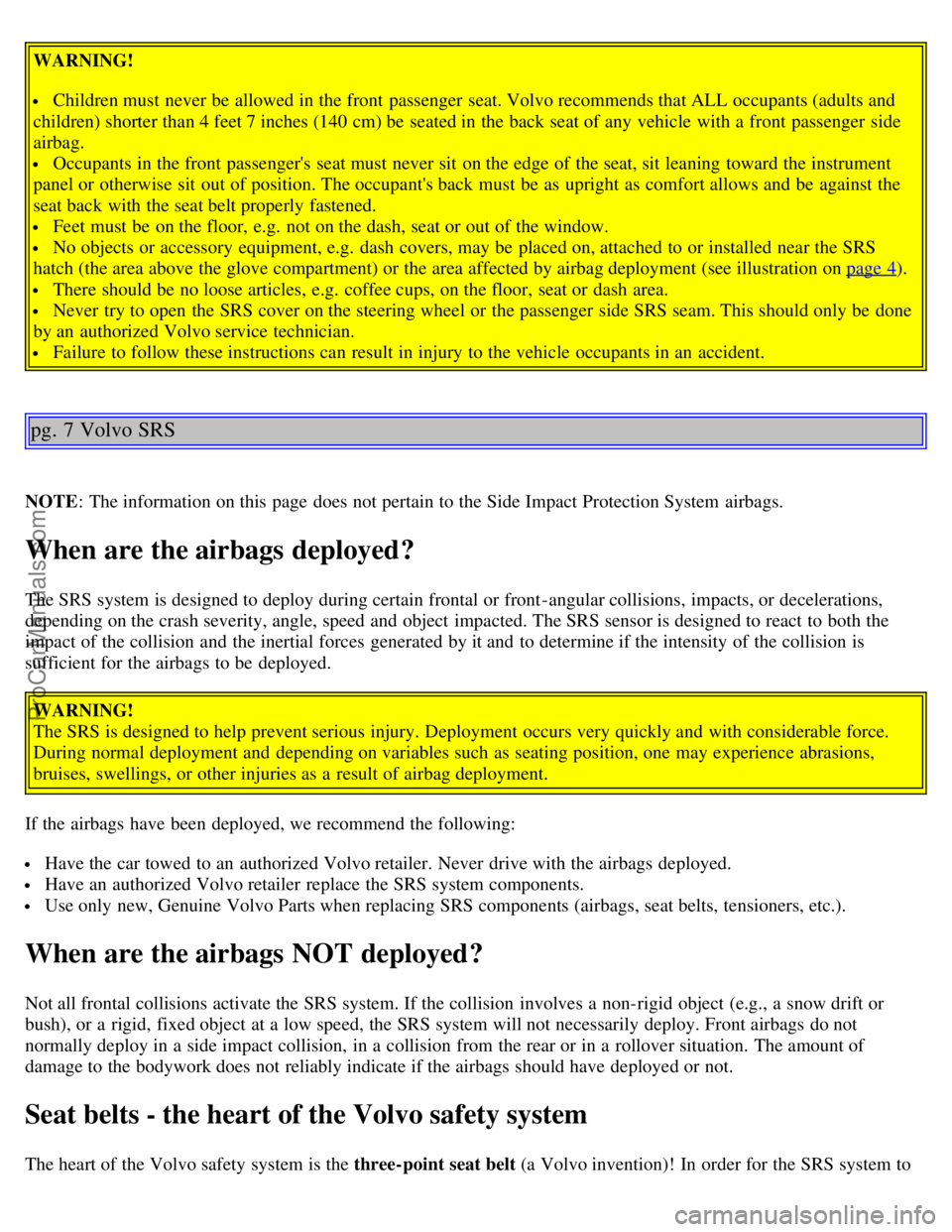
WARNING!
Children must never be allowed in the front passenger seat. Volvo recommends that ALL occupants (adults and
children) shorter than 4 feet 7 inches (140 cm) be seated in the back seat of any vehicle with a front passenger side
airbag.
Occupants in the front passenger's seat must never sit on the edge of the seat, sit leaning toward the instrument
panel or otherwise sit out of position. The occupant's back must be as upright as comfort allows and be against the
seat back with the seat belt properly fastened.
Feet must be on the floor, e.g. not on the dash, seat or out of the window.
No objects or accessory equipment, e.g. dash covers, may be placed on, attached to or installed near the SRS
hatch (the area above the glove compartment) or the area affected by airbag deployment (see illustration on page 4
).
There should be no loose articles, e.g. coffee cups, on the floor, seat or dash area.
Never try to open the SRS cover on the steering wheel or the passenger side SRS seam. This should only be done
by an authorized Volvo service technician.
Failure to follow these instructions can result in injury to the vehicle occupants in an accident.
pg. 7 Volvo SRS
NOTE : The information on this page does not pertain to the Side Impact Protection System airbags.
When are the airbags deployed?
The SRS system is designed to deploy during certain frontal or front -angular collisions, impacts, or decelerations,
depending on the crash severity, angle, speed and object impacted. The SRS sensor is designed to react to both the
impact of the collision and the inertial forces generated by it and to determine if the intensity of the collision is
sufficient for the airbags to be deployed.
WARNING!
The SRS is designed to help prevent serious injury. Deployment occurs very quickly and with considerable force.
During normal deployment and depending on variables such as seating position, one may experience abrasions,
bruises, swellings, or other injuries as a result of airbag deployment.
If the airbags have been deployed, we recommend the following:
Have the car towed to an authorized Volvo retailer. Never drive with the airbags deployed.
Have an authorized Volvo retailer replace the SRS system components.
Use only new, Genuine Volvo Parts when replacing SRS components (airbags, seat belts, tensioners, etc.).
When are the airbags NOT deployed?
Not all frontal collisions activate the SRS system. If the collision involves a non-rigid object (e.g., a snow drift or
bush), or a rigid, fixed object at a low speed, the SRS system will not necessarily deploy. Front airbags do not
normally deploy in a side impact collision, in a collision from the rear or in a rollover situation. The amount of
damage to the bodywork does not reliably indicate if the airbags should have deployed or not.
Seat belts - the heart of the Volvo safety system
The heart of the Volvo safety system is the three-point seat belt (a Volvo invention)! In order for the SRS system to
ProCarManuals.com
Page 12 of 85
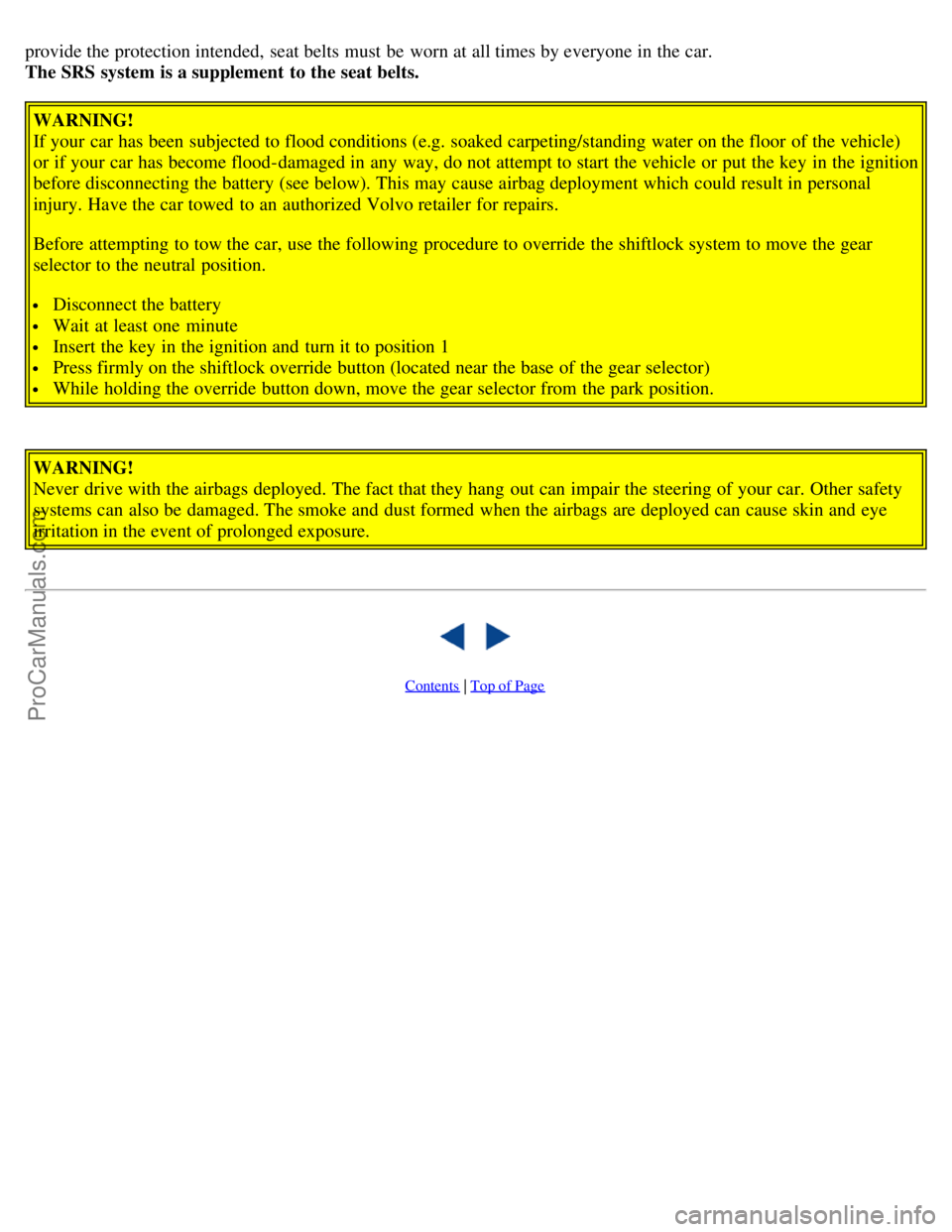
provide the protection intended, seat belts must be worn at all times by everyone in the car.
The SRS system is a supplement to the seat belts.WARNING!
If your car has been subjected to flood conditions (e.g. soaked carpeting/standing water on the floor of the vehicle)
or if your car has become flood-damaged in any way, do not attempt to start the vehicle or put the key in the ignition
before disconnecting the battery (see below). This may cause airbag deployment which could result in personal
injury. Have the car towed to an authorized Volvo retailer for repairs.
Before attempting to tow the car, use the following procedure to override the shiftlock system to move the gear
selector to the neutral position.
Disconnect the battery
Wait at least one minute
Insert the key in the ignition and turn it to position 1
Press firmly on the shiftlock override button (located near the base of the gear selector)
While holding the override button down, move the gear selector from the park position.
WARNING!
Never drive with the airbags deployed. The fact that they hang out can impair the steering of your car. Other safety
systems can also be damaged. The smoke and dust formed when the airbags are deployed can cause skin and eye
irritation in the event of prolonged exposure.
Contents | Top of Page
ProCarManuals.com
Page 13 of 85
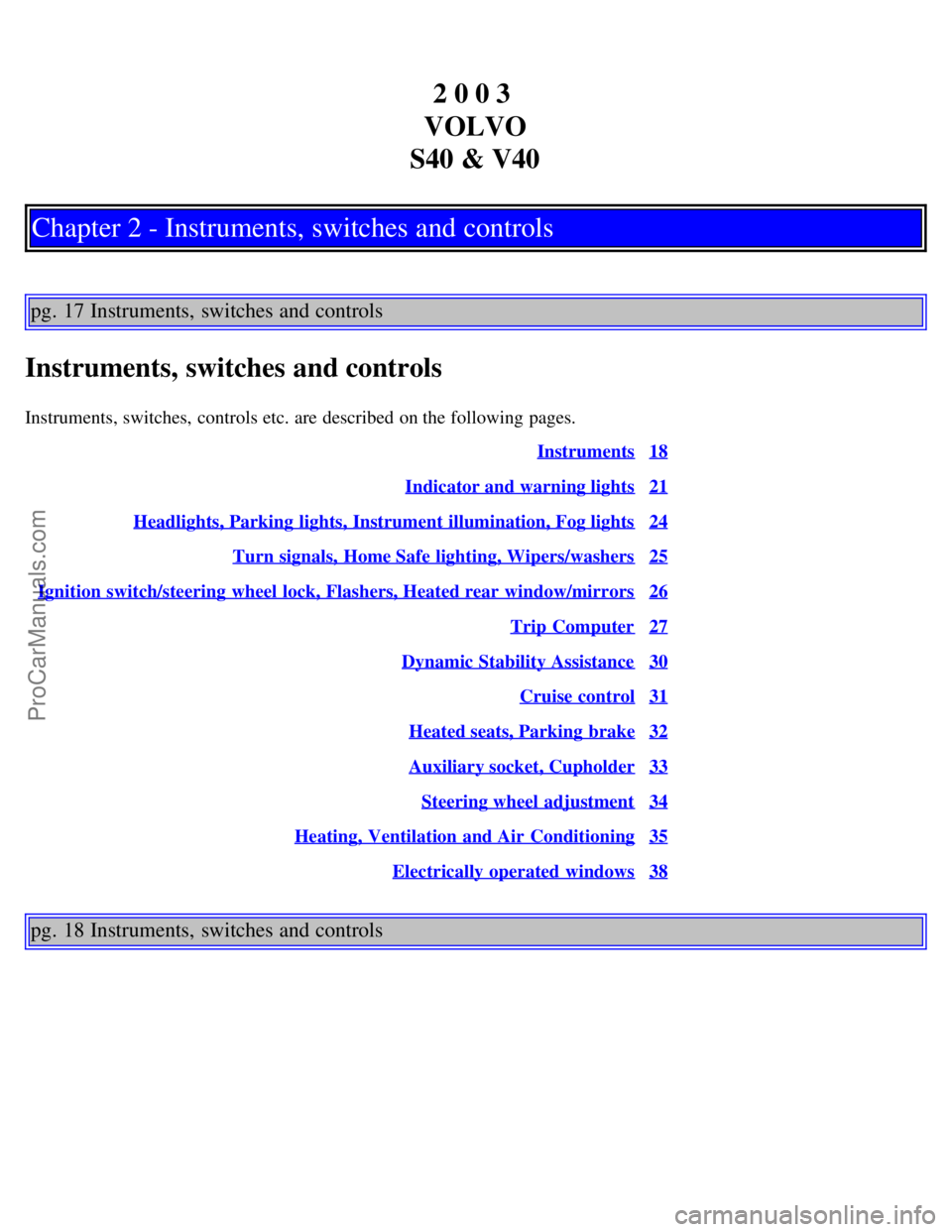
2 0 0 3
VOLVO
S40 & V40
Chapter 2 - Instruments, switches and controls
pg. 17 Instruments, switches and controls
Instruments, switches and controls
Instruments, switches, controls etc. are described on the following pages. Instruments
18
Indicator and warning lights21
Headlights, Parking lights, Instrument illumination, Fog lights24
Turn signals, Home Safe lighting, Wipers/washers25
Ignition switch/steering wheel lock, Flashers, Heated rear window/mirrors26
Trip Computer27
Dynamic Stability Assistance30
Cruise control31
Heated seats, Parking brake32
Auxiliary socket, Cupholder33
Steering wheel adjustment34
Heating, Ventilation and Air Conditioning35
Electrically operated windows38
pg. 18 Instruments, switches and controls
ProCarManuals.com
Page 14 of 85

pg. 19 Instruments, switches and controls
The pages in this section provide detailed descriptions of the vehicle's instruments and controls. Note that vehicles may
be equipped differently, depending on special legal requirements.Page
1 Adjustable door mirrors 50
2Air vents 35
3Headlight switch 24
4Front foglight 24
5Instrument lighting 24
6Rear foglight 24
7Turn signals, high/low beams, Home Safe Lighting, cruise control 25, 31
8Instruments, indicator and warning lights 20-21
9Horn
10 Windshield wash/wipe, headlight wash/wipe 25
11Blower control 36
12Air distribution control 36
13Hazard warning flashers 26
14Passenger compartment temperature sensor 36
15Temperature control 36
16Glove compartment 45
17Passenger airbag 4
18Sunlight sensor for electronic climate control and LED for immobilizer and alarm 37, 44
19Fuse box 96-97
ProCarManuals.com
Page 15 of 85
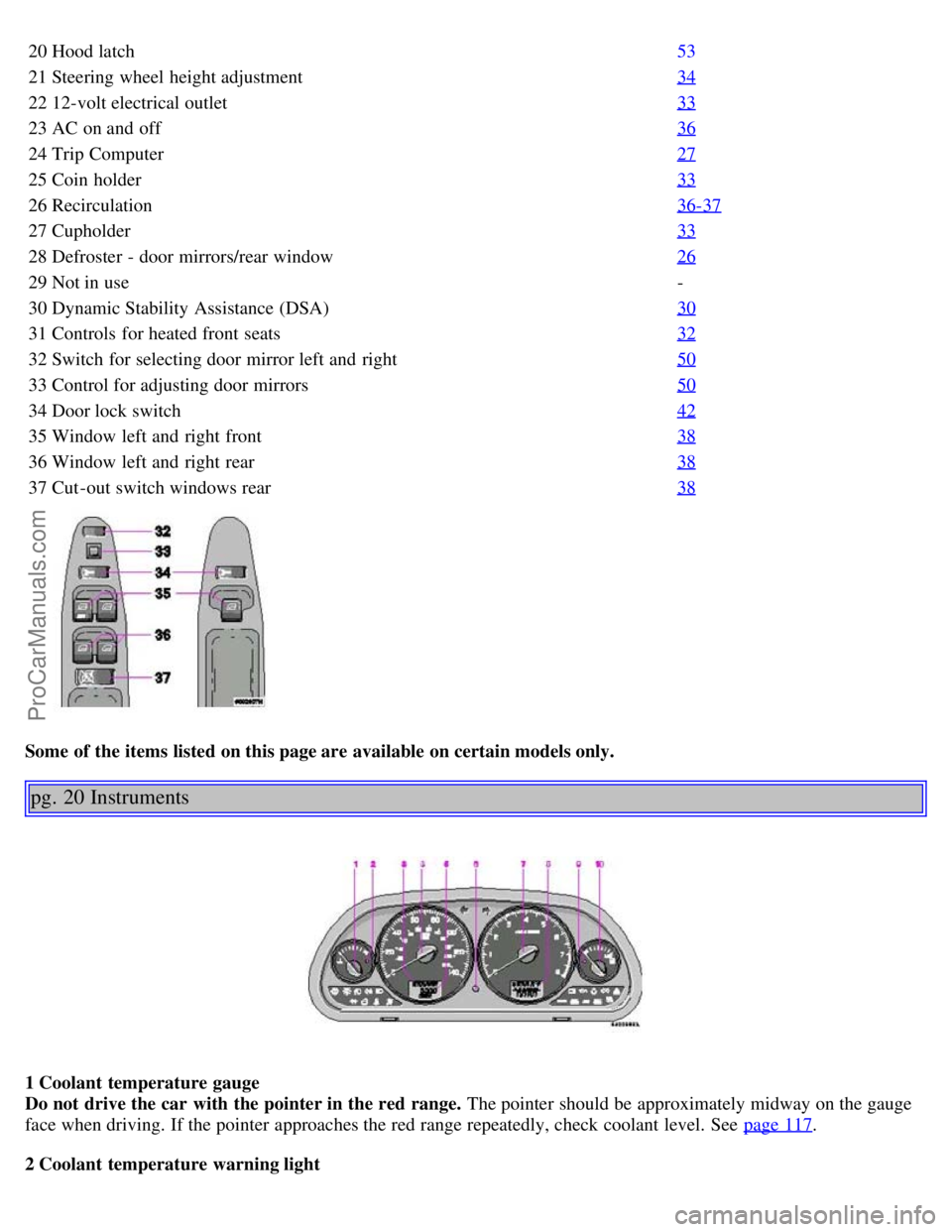
20Hood latch 53
21Steering wheel height adjustment 34
2212-volt electrical outlet 33
23AC on and off 36
24Trip Computer 27
25Coin holder 33
26Recirculation 36-37
27Cupholder 33
28Defroster - door mirrors/rear window 26
29Not in use -
30 Dynamic Stability Assistance (DSA) 30
31Controls for heated front seats 32
32Switch for selecting door mirror left and right 50
33Control for adjusting door mirrors 50
34Door lock switch 42
35Window left and right front 38
36Window left and right rear 38
37Cut -out switch windows rear 38
Some of the items listed on this page are available on certain models only.
pg. 20 Instruments
1 Coolant temperature gauge
Do not drive the car with the pointer in the red range. The pointer should be approximately midway on the gauge
face when driving. If the pointer approaches the red range repeatedly, check coolant level. See page 117
.
2 Coolant temperature warning light
ProCarManuals.com